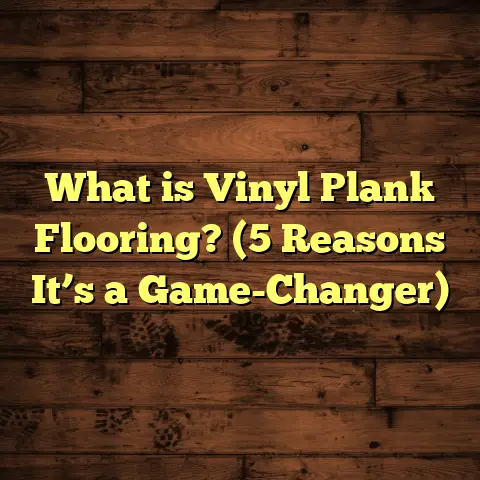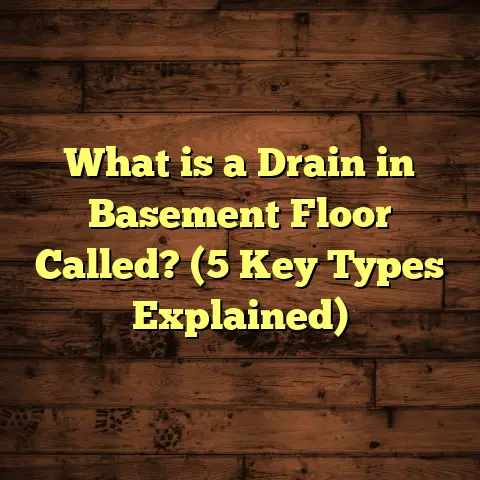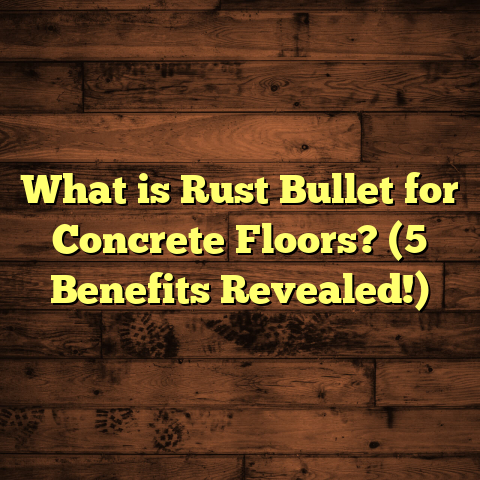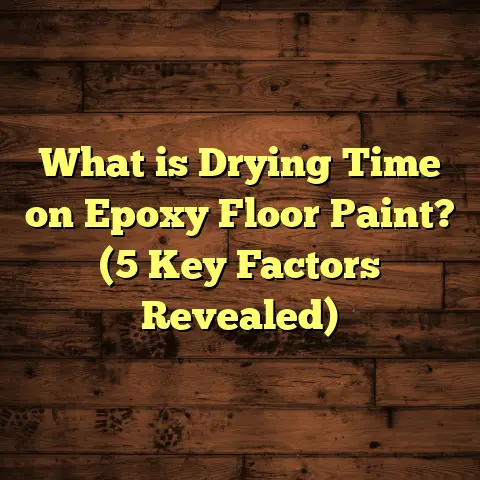What is Underfloor Material If Not Hardwood? (5 Surprising Options)
What is Underfloor Material If Not Hardwood?
Hey, can I be honest here? When you’re thinking about floors for your home, hardwood is usually the first thing that comes to mind—rich, warm, timeless. But what if I told you that hardwood isn’t the only option? Or better yet, what if hardwood isn’t always the best option? Yeah, I know. It sounds surprising. But there are plenty of other materials that might actually fit your needs better than hardwood, depending on your space, lifestyle, and budget.
I’ve been working with flooring for years now—installing, fixing, advising—and one thing I’ve learned is that the material under your feet makes a massive difference. It’s not just about looks; it’s about comfort, durability, maintenance, cost, and even how your home feels when you walk across it.
Listen, if you’re considering new floors or renovations right now, this is something you really want to get right the first time. Because trust me, making the wrong choice can lead to headaches like warping, cracking, or spending more than you wanted on repairs.
So let’s chat about five underfloor materials that aren’t hardwood but might just be perfect for you.
What is Underfloor Material If Not Hardwood?
When I say “underfloor material,” I’m talking about the surface material that covers your floor joists or subfloor—the stuff you actually walk on every day. Hardwood is one option—made from solid planks of wood—but there’s a whole world of alternatives that can function as well or better depending on your home’s conditions and your lifestyle.
These materials vary in:
- Durability: How long they last under daily wear.
- Moisture resistance: Can they handle spills or humidity?
- Comfort: Are they soft or hard underfoot?
- Cost: How much will installation and upkeep set you back?
- Maintenance: What kind of care do they need?
- Style options: Can they mimic wood or offer different looks?
By the end of this article, you’ll have a solid understanding of five surprising options that can replace hardwood on your floors—and tips on when and why each one makes sense.
1. Cork Flooring: The Comfort King You Didn’t Expect
I want to start with cork because it’s one of those materials people don’t think about much. But after working with cork floors on several projects, I’m a huge fan.
Why Cork Feels Different
Imagine walking barefoot on a floor that feels like it has a little bounce. Cork offers natural cushioning thanks to its cellular structure filled with air pockets. This means it absorbs shock better than hardwood or tile. If you’ve ever had hardwood floors that felt cold or hard in winter mornings, cork could be a game-changer.
Real-Life Experience
One of my clients was an elderly couple who wanted something softer for their kitchen floor because standing there cooking for long periods gave them foot pain. We installed cork flooring and within weeks they told me it was like the floor “hugged their feet.” Hearing that made me realize how much comfort underfoot matters.
Durability Meets Eco-Friendly
Cork comes from the bark of cork oak trees harvested every 9 years without killing the tree. That’s why cork is considered sustainable—a big plus if you care about the environment.
But what about durability? Cork is surprisingly tough. It resists cracking and abrasion better than many people expect. According to a technical study by JEC Composites Magazine, cork flooring can withstand 1,000 cycles of abrasion testing with minimal wear. That means it holds up well in homes with moderate foot traffic.
Soundproofing Bonus
If you live in an apartment or multi-level house, noise travels. Cork’s natural sound-insulating properties can reduce impact noise by up to 43%, per research published by Building Acoustics Journal. That means less noise complaints from neighbors below and a quieter home overall.
What You Should Know Before Installation
- Cork is water-resistant but not waterproof. Liquid spills should be wiped up quickly.
- It needs sealing every few years to protect against moisture.
- Avoid placing heavy furniture without protective pads; cork can dent under pressure.
If your home sees moderate use and you want warm, cushioned floors that are gentle on joints and the planet, give cork a serious look.
2. Bamboo Flooring: Grass That Acts Like Wood
You might hear “bamboo” and think “grass,” which it is—but bamboo flooring looks so much like wood that most people don’t notice the difference.
The Strength Is Real
Bamboo grows fast—like crazy fast compared to hardwood trees—and it’s incredibly strong. On the Janka hardness scale (which measures wood hardness), some bamboo species rank between 1,200 to 1,400 pounds of force, which is harder than oak (1,200) and comparable to hickory (1,820). This means bamboo floors resist dents and scratches better than many traditional hardwoods.
My Bamboo Story
I installed bamboo in a family home with three kids and two dogs. The parents wanted something durable yet stylish without breaking the bank. After two years, the floor still looked fantastic despite all the wear and tear. They loved how easy it was to clean too—just sweeping and occasional mopping kept it looking fresh.
Environmental Perks
Since bamboo regenerates quickly—some species can grow up to 3 feet per day—it’s an eco-friendly resource compared to slow-growing hardwood trees that take decades to mature.
Moisture Resistance
Bamboo handles humidity better than traditional hardwood but isn’t waterproof. Engineered bamboo options add a layer of protection against moisture by layering bamboo over plywood substrates.
Installation Tips
- Bamboo should acclimate to your home environment before installation (usually 48-72 hours).
- Engineered bamboo tends to be more stable for areas prone to moisture.
- Avoid glue-down methods in humid areas; nail-down or floating floors work better.
Want a floor that combines natural strength with sustainability? Bamboo could be your answer.
3. Vinyl Flooring: The Comeback Kid
Years ago, vinyl had a reputation for cheapness and lackluster looks. But today’s vinyl flooring is miles ahead and deserves serious attention when you’re looking beyond hardwood.
Realistic Looks That Fool Experts
With today’s printing technology and wear layers, vinyl planks can mimic hardwood grains so closely even flooring pros stop and take a second look. You get the aesthetic appeal without many downsides of real wood.
Waterproof Wonder
If you’ve ever dealt with spilled drinks, pet accidents, or humidity in bathrooms and basements, vinyl shines here. It’s fully waterproof and won’t warp or swell like wood does when exposed to moisture.
Cost-Effective and Durable
Vinyl is generally more affordable than hardwood or engineered wood. High-quality vinyl floors can last 10-20 years with regular maintenance.
I installed vinyl plank flooring in a basement renovation where water intrusion was common during heavy rains. The vinyl held up perfectly while their previous hardwood floors buckled within months.
Easy Upkeep
Vinyl floors require little maintenance beyond regular sweeping and damp mopping. No need for refinishing or special cleaners.
What to Watch For
- Cheaper vinyl can feel thin and plasticky.
- Some low-end products may peel or fade over time.
- Always choose vinyl with at least 12 mil wear layer thickness for residential use.
If budget constraints or moisture concerns are high on your list, vinyl is a smart choice.
4. Engineered Wood: Best of Both Worlds?
This one’s popular for a reason: engineered wood offers genuine wood beauty combined with improved stability over solid hardwood.
How Engineered Wood Works
It consists of multiple layers: a top veneer of real hardwood glued over plywood or fiberboard layers beneath. This cross-layer construction reduces expansion/contraction issues caused by humidity changes.
My Radiant Heat Project
One project stands out: installing flooring over radiant heat systems. Solid hardwood often struggles here because it expands too much with heat fluctuations leading to gaps or warping. Engineered wood handled it perfectly—warm underfoot without any damage after two winters.
Cost & Installation Benefits
Engineered wood tends to cost less than solid hardwood while delivering similar aesthetics. Many products can be installed as floating floors without nails or glue—cutting down installation time and labor costs.
A report from Floor Covering Weekly noted a 30% increase in engineered wood sales over five years due to these advantages.
Maintenance & Longevity
Engineered wood can be sanded and refinished but fewer times than solid hardwood because of thinner top veneers (usually 2-4mm thick).
5. Concrete Overlay: Industrial Style Meets Functionality
Concrete floors often get dismissed as cold or utilitarian but concrete overlays prove otherwise—they can be stylish and surprisingly comfortable with the right finish.
Durability Like No Other
Concrete is extremely durable—lasts decades when sealed properly—and resists scratches better than wood.
I recently worked on converting an old garage into a modern living space using stained concrete overlay. The homeowner loved the sleek look and how easy it was to clean after kids tracked in dirt from outside.
Customization Options
You can stain concrete in various colors or polish it for shine. Stamped overlays add patterns mimicking stone or tile. That means no cookie-cutter floors here!
Warmth & Comfort?
While concrete feels cold initially, pairing it with radiant floor heating makes it cozy year-round—a feature many homeowners appreciate in colder climates.
The Concrete Network reports polished concrete floors have lifespans exceeding 40 years when maintained properly—far outlasting many wood options.
How Do You Decide Which One Works Best?
Picking the right floor material depends on lots of factors beyond just looks:
| Factor | Cork | Bamboo | Vinyl | Engineered Wood | Concrete Overlay |
|---|---|---|---|---|---|
| Comfort | Very soft & cushioned | Medium – firm | Medium – firm | Firm | Hard |
| Moisture Resistance | Moderate (sealed required) | Moderate | Excellent | Moderate | Excellent |
| Durability | Moderate | High | High | High | Very high |
| Maintenance | Low to moderate | Low | Low | Moderate | Low |
| Cost | Mid-range | Mid-range | Low | Mid to high | Low |
| Noise Insulation | Excellent | Moderate | Moderate | Moderate | Poor |
| Installation Difficulty | Moderate | Moderate | Easy | Moderate | Advanced |
Ask yourself questions like:
- Does my home have moisture problems?
- Am I okay with occasional maintenance?
- Do I want something soft or firm underfoot?
- How much traffic will my floors see daily?
- What’s my budget for installation and upkeep?
A Few Lessons from My Years in Flooring
I want to share some real insights that don’t always get talked about:
- Moisture kills hardwood fast: If you don’t have a super dry environment or proper vapor barriers, hardwood will swell and warp faster than you expect.
- Comfort matters: Floors you stand on for hours (kitchens) should offer some cushioning—otherwise expect foot fatigue.
- Don’t skimp on underlayment: Good underlayment improves comfort, soundproofing, and protects against moisture.
- Samples are key: I always tell clients to bring samples home for days so they see how light affects color and texture.
- Installation quality beats material choice: A great installer can make cheaper materials look amazing; poor installation ruins even expensive wood floors.
Real Case Studies From My Projects
Case Study 1: Cork in a Senior’s Kitchen
Mrs. H wanted something soft underfoot but stylish in her kitchen. We picked cork flooring sealed three times for moisture resistance. After one year she reported no dents despite heavy use plus less joint pain standing while cooking.
Case Study 2: Bamboo in a Family Room
The Martins had three young kids and pets running around — they needed durability but didn’t want laminate’s plastic feel. Bamboo flooring held up beautifully after two years with minor scratches easily repaired by sanding.
Case Study 3: Vinyl in a Basement Gym
Mr. J converted his damp basement into a home gym. Vinyl plank flooring gave him the look he wanted without worries about sweat or water damage from equipment spills.
Case Study 4: Engineered Wood Over Radiant Heat
The Smiths installed radiant heat but wanted real wood feel upstairs. Engineered wood performed flawlessly through two winters without gaps or squeaks.
Case Study 5: Concrete Overlay in Urban Loft
A young couple transformed their garage into a trendy living space with stained concrete overlay—it was stylish, tough enough for pets, and easy to clean after parties.
Wrapping Up: Your Floor, Your Choice
I hope this makes clear there’s no one-size-fits-all answer when choosing underfloor materials other than hardwood. Each option has tradeoffs—comfort vs durability vs cost—but knowing these five choices gives you real power when planning your floors.
If you want help figuring out what fits best for your space or have questions about installation or maintenance specifics, just ask me! I’ve seen these materials in action countless times and am happy to share what works best based on where you live, your lifestyle, and budget.
Remember: good floors don’t just look great—they feel great too every day you’re at home.
Ready to explore more? Let me know what kind of room you’re working on or any challenges you’re facing with your current floors—I’m here to help!





